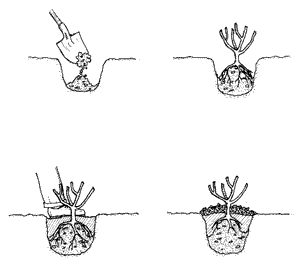The Right Place
All roses thrive in locations enjoying good sun and air circulation. They help dew or rain on the leaves to dry quickly, discouraging disease problems. Roses need bright sun at least 5 to 6 hours a day. Try to locate rose bushes so that they enjoy morning sunlight and some shade in the afternoon to protect them from the scorching summer afternoon sun. Although most roses tolerate filtered shade, too much shade reduces the number of blossoms, encourages legginess and invites rust and mildew problems. Avoid locating rose bushes on sites that are exposed to prevailing winds. Too much wind will damage the foliage in the summer and hurt the canes in the winter. Do no plant them too close to large trees that compete with them for soil nutrients.
Roses prefer a soil that is fertile and well drained, containing sufficient organic material such as peat moss that it retains moisture. Roses like a slightly acid soil (pH 6.0 to 6.5) which peat moss enhances. Most bush roses are sold "bare root" by mail or through nurseries in the spring. They have been dug from the field at 2 years old or so, their roots are less likely to have been cramped and crowded than containerized plants.
Planting Nursery Stock
Plant bush roses in most parts of the country in the early spring before the plant begins to show green buds. If you cannot plant bare root types as soon as you acquire them, keep them dormant by dampening the roots and storing them in a cool dark place for up to two weeks. Plant either bare root or container roses any time during their dormant season when the soil is not frozen. In the South, Southwest, and on the West Coast that may be in January or February. Bush roses raised in containers can be planted almost any time during the growing season.
Plant bush roses as you would any shrub. Because their roots will eventually grow to 16 or 18 inches deep, try to loosen the soil as deeply as possible. Experiments have proven that roses planted in more shallowly prepared soil will give results equal to those of roses in deep beds during the first year, but after the second year the roses in beds cultivated to 24 inches deep are superior.
Planting depth varies with climate, the depth of the bud union, (the bulbous or swollen shape just above the roots where the flowering stock was grafted to the root stock), being most important. In the South, plant bush roses with the bud union even with the soil surface. In the North place the plant so the bud union is 2 to 4 inches below the surface of the soil, to protect it from winter cold. In the middle latitudes of the United States, place the bud union about an inch below the surface of the soil.
 |
Prior to planting, soak the bare roots of the rose bushes in a pail of water for at least six hours. Dig a hole wide enough to accommodate the spread roots and deep enough so that the bud union is at the correct level. Bare root roses from the nursery have had their tops shortened. In most cases additional pruning is still needed. Remove any weak twigs and shorten the main canes. Cut away all broken and dried roots until they fit into the planting hole without bending. Build a firm mound of soil in the center of the bottom of the hole and set the rose bush on the mound, arranging the bare roots down the sides of the dirt mound. Settle the bush into the hole, filling in and firming the soil gently around and over the roots to prevent air pockets. Water well. Add a 2 to 3 inch layer of mulch over the root zone to help the soil retain moisture.
Amendments In Planting or Transplanting
There are a number of products at the garden center that will help your newly planted or transplanted plants deal better with the stress inherent in the planting process. All healthy plants have beneficial fungi, called mycorrhizal fungi, living on their roots. You can buy these valuable additions to your plant’s ecosystem. See the file describing Using Micorrhizae When Planting.
In addition, there are a number of products such as seaweed, compost tea, and beneficial soil microbes that when added to the planting process will help your newly established plants get going faster. See the file New Technology In Plant Growth Activators
For more information see the file on Planting Shrubs. For planting tools see Hand Tools For Digging and Planting in Yardener’s Tool Shed.

